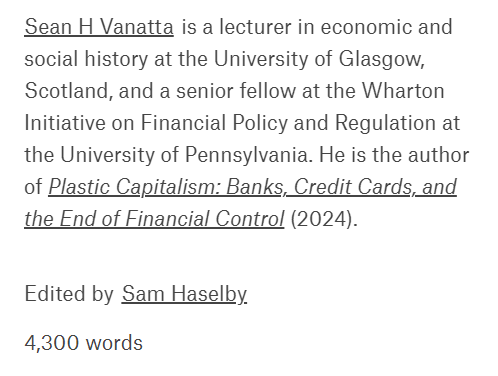General Discussion
Related: Editorials & Other Articles, Issue Forums, Alliance Forums, Region ForumsCredit card nation

Americans have always borrowed, but how exactly did their lives become so entangled with the power of plastic cards?
https://aeon.co/essays/how-did-america-become-the-nation-of-credit-cards


The American economy has always relied on household borrowing. Since before the founding, the colonies had been ever short of metallic currency. Our 18th-century forebears substituted credit for cash. They bought goods ‘on account’, borrowing to buy time until the harvest came in or some other windfall enabled them to repay what they owed. The 19th-century shift from agriculture to industry brought many American workers predictable wages and fixed salaries. Industrial businesses – selling sewing machines, pianos, home appliances, and especially automobiles – developed novel credit arrangements to transform steady paychecks into steady repayments. Instalment credit enabled consumers to purchase expensive durable goods with a small down payment, followed by weekly or monthly payments thereafter.
In cities, department stores refined another form of borrowing: the charge account. These accounts granted affluent consumers a fixed line of credit, which they repaid monthly without paying interest. Like instalment credit, charge accounts existed to sell goods, rather than generating profits from lending as such. Charge accounts made credit convenient, encouraging consumers to buy more. Convenience came in part through a new link between credit and identification media. Stores issued charge tokens and later charge plates – fobs and metal cards that carried consumer account information – granting affluent consumers the prestige of recognition in cities full of strangers. Mass consumer credit greased the wheels of mass production. In the early 20th century, proponents praised a virtuous lending cycle. Credit generated consumer demand; which encouraged industrial investment; which led to economies of scale, lower costs, and more industrial work; finally encouraging further consumer demand.

Critics worried that consumers, having committed future income to present consumption, would have no future buying power to turn the wheel the next cycle, or the next. ‘Larger and larger doses of the stimulant must be injected merely to prevent a relapse,’ two prominent critics warned in 1926. The Great Depression ended the debate. The 1929 stock market crash stalled credit buying. Consumers worried. They waited. They postponed credit purchases – a month, two months, three. Individual delays, in the aggregate, froze the economy. Without credit purchases, factories had fewer orders. With fewer orders, factories idled and laid off workers. Unemployed workers cut spending further. They did not borrow to buy. They did not buy at all. The virtuous credit circle that turned in the 1920s shuttered and stopped in the 1930s. Policymakers took an unexpected lesson from this experience: the United States’ industrial capacity had been built to run on a steady fuel of consumer borrowing. If private lenders would not provide that fuel, New Dealers reasoned, the federal government should.

The New Deal has many conflicting legacies but, from that point forward, federal policy unambiguously supported a political economy with household borrowing at the centre. Federal lending programmes legitimised credit buying by aligning it with national economic priorities of stable employment and steady growth. Those national priorities changed course when the nation shifted from recovery to warmaking during the Second World War. Policymakers wanted consumers to save, not spend, a policy the US Federal Reserve pursued through firm controls on consumer credit. Government controls encouraged credit innovation, first to circumvent the rules, then to comply with them. Policymakers initially targeted instalment credit, which consumers used to buy durable goods like cars and home appliances. Retailers, still eager to generate sales, modified their unregulated charge account plans to enable consumers to pay over longer periods of time. Charge accounts gained the now-familiar 30-days interest-free period, with interest charged monthly on the remaining balance.
snip


SleeplessinSoCal
(9,139 posts)I took advantage of low interest rate in 2016. Thus far (knock wood) we have paid no interest. We buy with cash or Amex, which is paid for each month. This was advised by a financial planner.
That's the only good thingI can think of that came out of 2016
Celerity
(43,494 posts)WhiteTara
(29,722 posts)and then came the replacement with credit cards.
Silent3
(15,263 posts)In my thirties I quit doing that and started paying off all balances in full every month, making rare exceptions for some 0% interest offers.
I don’t know if I can credit gaining discipline for that, or if it was merely a matter of reaching an income level where more spending was within reach without borrowing.
Chainfire
(17,620 posts)In middle age, when the kids were home, we went into credit card debt, bigtime. I didn't think that we would ever get out of that hole. We did when I got a job that had a lot of overtime. Never again! If I can't pay for it, I leave it in the store.
Liberal In Texas
(13,574 posts)Scot writer has used all these vintage Omaha pictures.
Unrelated "fun" fact: Emil Brandeis of Omaha, NE went down with the Titanic.